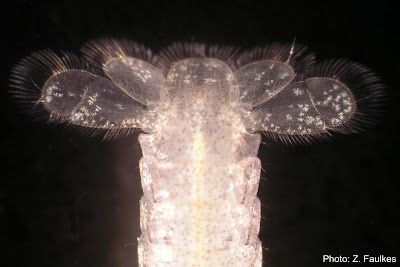
Unlike previous pictures, this picture of a juvenile's tailfan is actually part of a request for information.
What might look to be white spots on the tailfan are seen in close-up (click to enlarge the picture) to be lots of little snowflake shapes. I don't think this is part of the normal juvenile colouration; I strongly suspect this is a fungal infection. The juveniles are growing quite well, so I think that what's happening is that the fungus (if that's what it is) is getting lost each time the animal molts, so nothing serious has come of it yet.
If anyone can confirm that this is a fungus, has suggestions for treatment, and so on, please let me know.






3 comments:
Dear Zan,
You should try leaves of Terminalia catappa (also called Catappa leaves, Atafa, Bengal almond, Indian almond, Malabar almond, Singapore almond, Tropical almond, Umbrella tree, in German it is called Seemandelbaum-Blätter) and/or fruits of Black alder (also Black cones) – both have a fungicid and bacteriarestraining effect. Then: Change water, change water, change water and don't feed to much to minimize spores in the water an maximize hygenia.
If that does not help You could try to give some salt to the water. For the beginning I wouldn't take more than 1,5 grams per litre. I don't know if and how much salt Procambarus sp. (Marmorkrebs) can deal with.
My best wishes
Ollie/BEASTIEPENDENT (www.panzerwelten.de)
Oh, I forgot: If You want to try fish fungicid medicals You have to take care it does NOT contain ANY copper – since copper is a very heavy poison für any decapod.
Ollie/BEASTIEPENDENT (www.panzerwelten.de)
This probably could be a case of "white spot syndrome virus (WSSV) infection", perhaps a fungus infection might be secondarily, just a guess from the distance.
In case of just fungus the average remedies contain malachite green, NaCl concentrations should be more than 8ppt, but I don´t know if this species can handle this concentration generally.
check my comment on the "black spots" for...
Edgerton et al., 2002:
"Clinical signs of WSSV infection of Orconectes punctimanus and Procambarus sp.
included discolouration and mottling of the exoskeleton, primarily on the carapace and
occasionally on the chelipeds (Richman et al., 1997). Characteristic small white spots
develop on the inside surface of the cuticle of the carapace and appendages of infected
prawns (Chou et al., 1995)."
Post a Comment